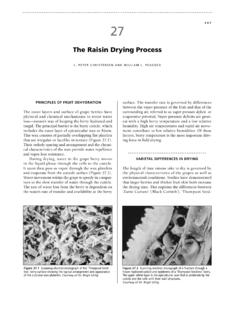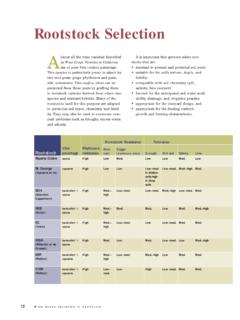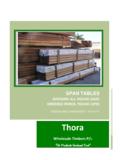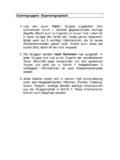Transcription of Rootstock Selection - University of California, Davis
1 Almost all the wine varieties described in Wine Grape Varieties in California are of pure Vitis vinifera parentage. This species is particularly prone to attack by two root pests: grape phylloxera and para-sitic nematodes. Vitis vinifera vines can be protected from these pests by grafting them to Rootstock varieties derived from other vine species and resistant hybrids. Many of the rootstocks used for this purpose are adapted to particular soil types, chemistry, and fertil-ity. They may also be used to overcome vine-yard problems such as drought, excess water, and is important that growers select root-stocks that are: resistant to present and potential soil pests suitable for the soil s texture, depth, and fertility compatible with soil chemistry (pH, salinity, lime content) favored for the anticipated soil water avail-ability, drainage, and irrigation practice appropriate for the vineyard design, and appropriate for the fruiting variety s growth and fruiting Selection12 Wine Grape Varieties in California RootstockVitis parentagePhylloxera resistanceNematode Resistance ToleranceRoot knotDagger (Xiphinema index)DroughtWet soilSalinityLimeRiparia George (Rupestris du lot)rupestrisHighLowLowLow med.
2 In shallow soils; high in deep soilsLow ( Selection Oppenheim)berlandieri ripariaHighMed. highLow highLow (Kober)berlandieri ripariaHighMed. high5C (Teleki)berlandieri ripariaHighMed. highLow (Millardet et de Grasset)berlandieri high99R(Richter)berlandieri rupestrisHighMed. highLow (Richter)berlandieri rupestrisHighLow this publication, each wine variety s descrip-tion includes information on Rootstock suitability and experience. Additionally, the following table provides comparative information that may assist growers with Rootstock decisions. This infor-mation is based on written reports throughout Europe and the New World, including California. The ratings and comments provided here are based on prevalence in the literature and those reports most likely to fit California conditions. As more experience is gained in California s diverse viticulture envi-ronment, deviation from the information in the table can be expected.
3 Widespread University of California and grower Rootstock trials will con-tinue to provide updated information on root-stock performance. Growers should also consult with their Cooperative Extension farm advisor, other local growers, consultants, and nursery representatives when selecting a Rootstock . L. Peter Christensen Rootstock Selection 131 Influence on scion mineral nutrition refers to comparative petiole tissue levels of nutritional elements. not availableInfluence on scionSoil adaptationEase of propagationOther characteristicsVigorMineral nutrition1 Low , P: low K, Mg: low , well-drained, fertile, moist soilsHighEarly maturation; scions tend to overbear HighN: high P: low on low-P soils, high on high-P soilsK: high Deep soilsHighFruit set problems with some scions; latent virus tolerantLow : low : : med. highMg: , clay as a cool-region : med. highP, K, Zn: , Mg: med. highMoist, clay soilsHighSusceptible to phytoph-thora root rot; adapted to high-vigor varietiesLow : lowP, K: : med.
4 HighZn: low , clay soilsHigh LowN, P, K: lowMg: : low , fertile tend to overbear when youngMed. highP: : highMg: of acid scions may develop : : highK: low , Zn: soils; acid soilsLow slowly in wet soils 14 Wine Grape Varieties in California RootstockVitis parentagePhylloxera resistanceNematode Resistance ToleranceRoot knotDagger (Xiphinema index)DroughtWet soilSalinityLime140Ru(Ruggeri)berlandier i rupestrisHighLow highMed. high1103P(Paulsen)berlandieri rupestrisHighMed. highLowMed. highMed. (Couderc)riparia rup-estrisHighLowLowLow Mgt(Millardet et de Grasset)riparia rup-estrisHighMed. (Mal gue)riparia (cordifolia rupestris)HighLow High Low (Couderc)longii highLow Creek(Ramsey)champiniiHighHighLow highLow highLow (solonis Othello) DogridgeLow highMed. highLow (solonis Othello) DogridgeLow rotundifoliaHighLowHighLow LowLowRootstock Selection (continued) Rootstock Selection 15 Influence on scionSoil adaptationEase of propagationOther characteristicsVigorMineral nutrition1 HighN: med.
5 HighP, Mg: highK: lowAdapted to drought and acid poorly in non-irrigated, low K soilsMed. highN: med. highP, Mg: highK, Zn: low to drought and saline soilsHigh Low : med. highP, Ca: lowK, Mg, Zn: soilsHighSensitive to latent viruses; tolerant of cold , K: med. highP, Mg, Ca: lowZn: , clay soilsHigh , P: : med. highMg: lowMoist, deep soilsHigh : low , Mg, Ca: lowK: highHigh Mg soilsHighReadily Mg deficient in low Mg soilsLowN: lowK: med. highBest on fertile, to fine-textured soilsHighPoor on low-vigor sites; tolerates wet soilsHighN, P: highK: med. highZn, Mn: lowSandy, infertileLowTolerant to PhytophthoraVery highN, P: highK: : lowVery sandy, infertileLowPromotes excess vigor, poor fruit setMed. highN: lowP: : highZn: low loams and loamy sandsHigh HighN, P, K: highMg: , Mn: lowSandy to sandy loamsMed. highSensitive to latent virusesHighN, K: highP: low : lowPoor on coarse, sandy soils due to low root knot nema-tode toleranceVery lowTolerant of fanleaf virus1 Influence on scion mineral nutrition refers to comparative petiole tissue levels of nutritional degree of long-term phylloxera resistance is questionable due to the unknown Vitis vinifera parentage of these rootstocks .
6 Not availabl





